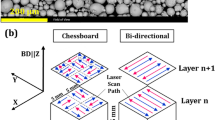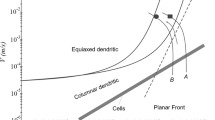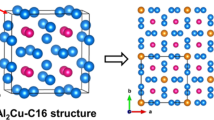Abstract
Hot cracking is a major problem in casting and laser welding of important technical aluminum alloys. A well-known method to reduce this problem is grain refinement. The mechanism of hot cracking prevention by grain refinement is not fully understood yet. In this study, different amounts of titanium and boron were added into weld in laser welding of AA 6082, which lead to different grain structures. A hot cracking test (DELTA test) was carried out to investigate the influence of grain refinement on hot cracking susceptibility of the welds. In order to understand the mechanism of hot cracking prevention by grain refinement, an analytical model was developed, which describes the influences of the grain structure and solidifications parameter on the three following factors, the duration of the mush zone, the capillary pressure for hot cracking, as well as the permeability of the dendritic network in the molten pool. It reveals that the hot cracking susceptibility is determined by the combination effect of these three factors. There is an optimum grain size for a minimal hot cracking susceptibility. It agrees with the experimental results in DELTA test.









Similar content being viewed by others
References
Reisgen U, Olschok S, Wagner N, Zäh M, Oefele F, Ruhstorfer M (2010) Aktuelle Fügevefahren für Alumniumwerkstoffe. DVS Bericht Strahlschweißen von Aluminium 22–27
Ostermann F (2007) Anwendungstechnologie Aluminium 2. Springer, Auflage
Dilthey U (2005) Schweißtechnische Fertigungsverfahren 2. Springer, Berlin, p 229
McCartney DG (1989) Grain refining of aluminium and its alloys using inoculants. Int Mater Rev 34:247–260
Dvornak MJ, Frost RH, Olson DL (1990) In: Patterson RA, Mahin KW (eds) Proc. of the materials weldability symposium held in conjunction with materials week. ASM International, Detroit, pp 289–295
Prokhorov NN, Jakuschin BF, Prochorow NN (1968) Theorie und Verfahren zum Bestimmen der technologischen Festigkeit von Metallen während des Kristallisationsprozesses beim Schweißen. Schweißtechnik 18:8–11, vorher Prochorow als erster!
Rappaz M, Drezet JM, Gremaud M (1999) A new hot-tearing criterion. Metall Mater Trans A 30:449–455
Cross E (2005) On the origin of weld solidification cracking. In: Böllinghaus T, Herold H (eds) Hot cracking phenomena in welds. Springer, Berlin, pp 3–18
Eskin DG, Suyitno, Katgerman L (2004) Mechanical properties in the semi-solid state and hot tearing of aluminium alloys. Prog Mater Sci 49(5):629–711
Katgerman L, Eskin DG (2008) In search of the prediction of hot cracking in aluminium alloys. In: Böllinghaus T (ed) Hot cracking phenomena in welds II. Springer, Berlin, pp 11–26
Quaak CJ (1996) Rheology of partial solidified aluminium composites, Ph.D. Thesis, TU Delft
Campbell J (1991) Castings. Butterworth-Heinemann, Oxford
Spittle JA, Cushway AA (1983) Influences of superheat on grain structure on hot-tearing susceptibilities of Al-Cu alloy castings. Met Technol 10:6–13
Kou S (2003) Welding metallurgy. Wiley, New Jersey
Pellini WS (1952) Strain theory of hot tearing. Foundry 80:125–133
Schempp P, Cross CE, Schwenk C, Rethmeier M (2012) Influence of Ti and B additions on grain size and weldability of aluminium alloy 6082. Weld World 56(9–10):95–104
Easton M, Grandfield J, StJohn D, Rinderer B (2006) The effect of grain refinement and cooling rate on the hot tearing of wrought aluminium alloys. Mater Sci Forum 519–521:1675–1680
Reitemeyer D (2012) Stabilisierung der Fokuslage beim Schweißen mit Faser- und Scheibenlasern. In: Vollertsen F, Bergmann R (eds) Strahltechnik Band 49. BIAS, Bremen
Tang Z, Schempp P, Seefeld T, Schwenk C, Vollertsen F (2011) Kornfeinung beim WIG- und Laserstrahlschweißen von Aluminiumlegierungen. In: DVS-Deutscher Verband f. Schweissen u. verwandte Verfahren e. V (ed) Große Schweißtechnische Tagung 2011 (GST 2011), DVS-Berichte Band 275. Dvs Media, Düsseldorf, pp 153–160
Voort V, George F (2004) ASM Handbook, Volume 09—Metallography and Microstructures. ASM International
Durdjevic MB, Duric B, Mitrasinovic A, Sokolowski JH (2003) Modelling of casting process parameters for the 3xx series of aluminum alloys using the silicon equivalency algorithm. Association of Metallurgical Engineers Serbia and Montenegro. 91–106
Du Y, Chang YA, Huang BY, Gong WP et al (2003) Diffusion coefficients of some solutes in fcc and liquid Al: critical evaluation and correlation. Mater Sci Eng A 363:140–151
Kurz W, Fischer DJ (1989) Fundamentals of solidification, 3rd edition. Trans Tech, Switzerland
Coniglio N (2008) Aluminium alloy weldability: identification of weld solidification cracking mechanisms through novel experimental technique and model development. Dissertation. BAM
Chai G, Bäckerud L, Rolland T, Arnberg L (1995) Dendrite coherency during equiaxed solidification in binary aluminum alloys. Metall Mater Trans A 26(4):965–970
Jácome P, Landim M C, Garcia A, Furtado A F, Ferreira I L (2011) The application of computational thermodynamics and a numerical model for the determination of surface tension and Gibbs–Thomson coefficient of aluminum based alloys, Thermochim. Acta 523:142–149
Grandfield JF, Davidson CJ, Taylor JA (2000) Application of a new hot tearing analysis to horizontal direct chill cast magnesium alloy AZ91. In: Ehrke K, Schneider W (eds) Continuous casting. Wiley, Weinheim, pp 205–210
Kutsuna M, Yan Q (1999) Study of porosity formation in laser welds of aluminium alloys (report 2): mechanism of porosity formation by hydrogen and magnetism. Weld Int 13:597–611
Cross CE, Olson DL, Edwards GR (1994) The role of porosity in initiating weld metal hot cracks. In: Zacharia T (ed). Modelling and control of joining processes. Miami 549–557
Kubo K, Pehlke R (1985) Mathematical modeling of porosity formation in solidification. Metall Trans B 16:359–366
Acknowledgements
This work was accomplished within the Center of Competence for Welding of Aluminum Alloys-Centr-Al. The authors appreciate the AIF (Allianz Industrie Forschung) of the German Federal Ministry of Economics and Technology for funding this work (Agreement No. 16.242N) and DVS for supporting the work.
Author information
Authors and Affiliations
Corresponding author
Additional information
Doc. IIW-2436, recommended for publication by Commission IV “Power Beam Processes”.
Rights and permissions
About this article
Cite this article
Tang, Z., Vollertsen, F. Influence of grain refinement on hot cracking in laser welding of aluminum. Weld World 58, 355–366 (2014). https://doi.org/10.1007/s40194-014-0121-3
Received:
Accepted:
Published:
Issue Date:
DOI: https://doi.org/10.1007/s40194-014-0121-3




